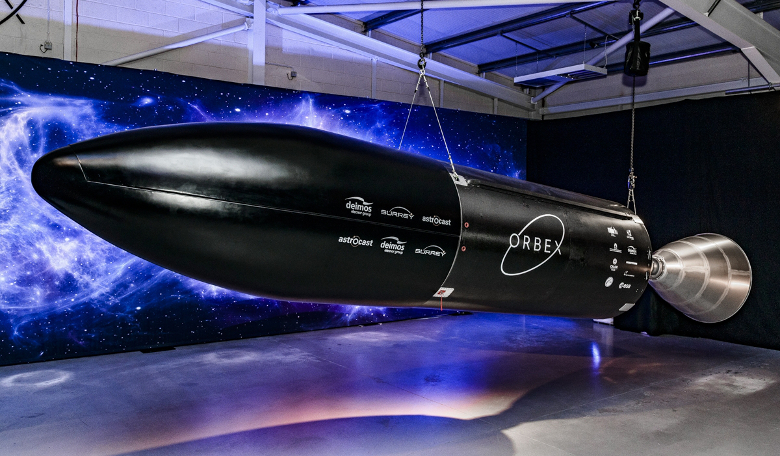UK satellite launcher developer Orbex has unveiled a new two-stage orbital vehicle, named Prime, at its development and production facility in Scotland. The sleek black second stage of the innovative rocket was revealed at the new headquarters of Orbex, which is relocating from London to Forres, in Moray District.
The vehicle contains a revolutionary propellent tanking system for a fuel never before used on a launch vehicle – liquid propane.
The Prime second stage is powered by a 30kN (3 tonne) engine, which has already been test-fired multiple times. The engine and associated turbo pumps are made by additive manufacturing in a single piece, the largest 3-D printed rocket engine in the world. SLM Solutions of Lubeck, Germany manufactures the rocket engine and its complex internal detail of cooling tubes.
The re-startable stage two engine is terminated by a large nozzle designed to operate in the vacuum of space.
The body shell is made of carbon fibre and aluminium composite, and there are two co-axial fuel tanks, an inner cylindrical tank containing the propane fuel, completely surrounded by an annular “sleeve” tank of liquid oxygen as oxidiser.
The design avoids the disadvantage of conventional propellent tanking in rockets, where the fuel tank sits atop the oxidiser tank (or vice versa), and the upper fluid has to be piped down through or past the lower propellant to the engine. In Orbex’s new design, both tanks have their base directly above the engine, so feeding the propellants into the combustion chamber is much simpler.
In another weight-saving benefit, the tank arrangement is superior to the usual set of tanks with hemispherical tops and bottoms, which create wasted space around them, and require extended fuselage lengths to accommodate them.
Propane is the only fuel which can be readily tanked in this way, surrounded by the LOX tank, without freezing. It remains liquid and densified by the chill, which further reduces the tank volume required.
As a result, the Prime vehicle is claimed to be 30 percent lighter and 20 percent more efficient than other small satellite launchers.
Orbex is partnering with Calor for supply of the bio-propane fuel required, a clean-burning renewable fuel source that cuts carbon emissions by 90 percent. It is chemically identical to the Calor gas (LPG) used for domestic heating and cooking.
The new second stage revealed at Forres is intended to carry small satellites on the final leg of their journey into polar or sun-synchronous orbit from the planned Moine Spaceport in Sutherland, on Scotland’s north coast. The stage is topped by a disposable split payload fairing to protect the cargo of satellites during launch through the atmosphere.
The design of the Prime rocket’s first stage remains to be disclosed, but is believed to incorporate innovative recovery systems to permit re-use of the stage. It will be powered by six of the same engines used in the second stage, albeit these models will have shorter nozzles for operation in the atmosphere, and will not be re-startable.
Orbex chief executive Chris Larmour stresses that rocketry is no longer the experimental science it once was. Advances in technology have meant that it is now a matter of applying knowledge and expertise that already exists, rather than pushing extreme boundaries. “We got our rocket’s guidance and navigation system from Elecnor Deimos Space, and it was already flight-proven. We didn’t have to re-invent it.”
The Orbex announcement of the launch vehicles details and the opening of its new production facility represents a further boost for Scotland’s fast-growing space sector, which includes advanced plans for orbital launch from the country, the first in Europe.
The company has purchased a 2,000 square metre building at The Enterprise Park in the town of Forres. It combines a rocket design and integration facility with an operations centre and executive offices. The Orbex venture is expected to create 130 jobs in the Scottish Highlands.
“As well as a full engineering prototype of the complete Stage Two, we now have a growing roster of customers hoping to be among the first to launch satellites from Scotland,” said Larmour.
The inaugural launch has already been booked by Surrey Satellite Technology Ltd (SSTL) of Guildford, which plans to loft an experimental payload.
Astrocast SA of Switzerland also intends to be on an early launch with their nanosatellites aimed to create a planet-wide ‘Internet of Things” network. In addition, Elecnor Deimos has contracted for up to 20 satellite launches.
The announcement of Orbex’s commitment to the Moine launch site on Scotland’s north coast is an important development for the £17.3 million project, which is funded by development agency Highlands & Islands Enterprise (HIE) and the UK Space Agency (UKSA).
Charlotte Wright, HIE chief executive, said: “Today is a significant day for Moray, whose economy is rich in aviation, technology and advanced engineering skills, stemming from the RAF presence and the energy sector.”
Graham Turnock, chief executive of the UK Space Agency said: “Orbex’s new rocket design facility brings us one step closer to having our own domestic commercial launch capability. We are Europe’s front-runner for those looking to Earth’s orbit for new opportunities.”











